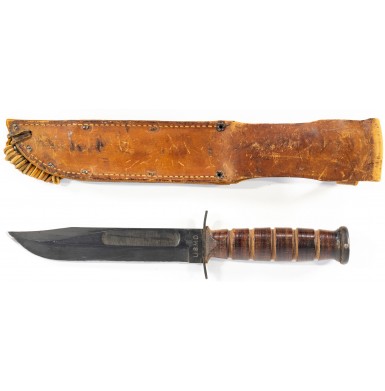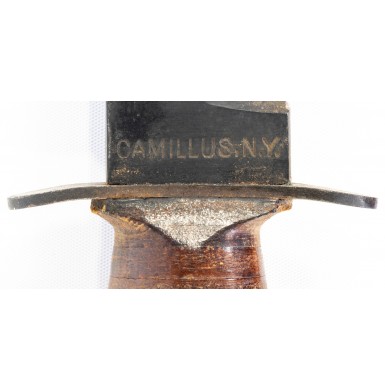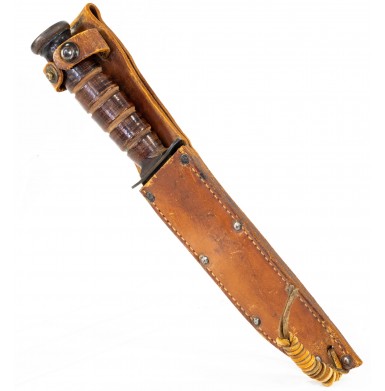Very Fine WWII Blade Marked Camillus USMC Fighting Utility Knife
- Product Code: EWSK-1673-SOLD
- Availability: Out Of Stock
-
$595.00
There is probably no US fighting knife more from the Second World War associated with the fighting in the Pacific theater than the USMC Mk 2 pattern combat knife, better known to the Marines who carried it at the KA-BAR. Marine Lieutenant Colonel Clifford H Shuey designed the USMC 1219C2 Combat Knife (later re-designated as the USMC Mk 2 Combat Knife) and eventually simply as “Knife, Fighting Utility” in 1942 and it was officially adopted in November of that year. The knife was essentially the same knife the Navy adopted as the USN Mk 2 and had a 7” clip-point, Bowie-style blade with steel cross guard and a hilt made of stacked leather washers. The overall length of the knife was 12” and the blades were delivered with a variety of finishes including blued, blackened, Parkerized or even plated, depending upon the manufacturer; and the period of time when the manufacturer produced the knives. In general, the highest level of polishing and finish was found on the early production knives that were often delivered with beautifully blued blades, while the later war knives often exhibited a lower level of metal polishing and surface preparation and were generally Parkerized. Pommel caps were secured by a variety of methods, including screwed on with washers, peened tangs and pinned tangs, just to name a few. Some of the makers even used different methods to secure the pommel cap to the knife tang during the course of their production runs, with the later war knives typically adopting the less expensive and most expeditious methods of production. The initial deliveries were made by the Union Cutlery Company and were marked with their trademark name KA-BAR. Even though the knife was produced by three other companies during the war, the Marines referred to the knives generically as the “KA-BAR”, and still use that name for their fighting-utility knife today. The knives began to be issued to the Marines in early 1943.
While the early production Navy version of the knife was marked USN or USN Mk 2 on the blade and had the maker’s name on the opposite side, the Marine Corps knives were marked USMC on one side of the ricasso and with the makers name on the other side. Early US Navy knives were issued in leather sheaths, which were eventually replaced by gray composite sheaths by early-to-mid 1944. The salt air and sea spray that the navy knives were exposed to was very tough on the leather scabbards, so the composite scabbard was a better choice for long term use in such an adverse environment. Amazingly, even though the Marine knives saw use in equally harsh, if not harsher conditions, the Marines utilized leather sheaths throughout the entire war. Due to problems in the field with broken blades, the government ordered that the markings be moved from the blade ricasso to the face of the cross guards in 1944. As a result, the early, blade marked knives are less common and more actively sought after by collectors than the later production, guard marked knives.
During the war Camillus, the Pal Blade Company and Robeson Shuredge also produced the “Ka-Bar” USMC fighting knife. Union Cutlery (KaBar) delivered the majority of the USMC fighting knives, with Camillus, PAL and Robeson delivering a significantly smaller number of knives, in that order. Today, Pal, and especially Robeson USMC knives are extremely rare and desirable for WWII USMC knife collectors. In particular the Robeson knives are highly prized as they were not only the contractor who delivered the smallest number of knives, but they also delivered what were generally considered to be the highest quality knives.
This particular USMC 1219C2 Combat Knife was produced by the Camillus Company of Camillus, NY and is in VERY FINE condition. This knife is blade marked was likely produced circa mid-1942 to sometime in 1944, prior to the change in marking requirements that moved the markings from the blade to the face of the guard. Interestingly, Camillus was the maker of the USMC 1219C2 knife that actually changed the location of the markings on their World War II USMC contract knifes. In his book U.S. and Allied Military Knives – World War II, Bill Walters identifies ten specific variations of the KA-BAR produced USMC knives that are blade marked and fifteen variations in the leather scabbards that accompanied them. However, he notes only three variants of the Camillus knives. Those three variants are 1) Blade Marked Parkerized Knives, 2) Guard Marked Parkerized Knives and finally 3) Guard Marked Chrome Plated Knives. Also, only two scabbard variations are noted. The first is a Boyt produced sewn scabbard with staple reinforcements and the second is believed to have been manufactured by the A.L. Siegel Company. This sewn scabbard was reinforced with rivets, with the two upper rivets at the scabbards throat having a flat profile and the other seven rivets being rounded, with domed tops. Camillus used a full-tang blade that was secured to the pommel cap with a pin. Other than the 7th Generation KA-BAR produced knives, only Camillus used a pinned pommel cap during their World War II production. Camillus also never used any black or red Bakelite washers in the production of their knives, so the grips are always made completely of leather washers with no other materials used.
As previously noted, this Blade Marked Camillus USMC 1219C2 Combat Knife remains in VERY FINE condition. The reverse ricasso is crisply marked USMC and the reverse ricasso is clearly marked in a single line CAMILLUS, N.Y.The knife has the expected pinned pommel cap with a leather washer handle that has five moderately wide grooves in it. The blade still retains about 85%+ of its original Parkerized finish, with some thinning and loss due to carry and insertion and removal from the scabbard. The blade shows a higher level of metal polish than is typical with later war knives and the neatly applied Parkerizing is so much smoother and evenly applied that it almost looks like a dull military blued finish. In addition to some minor thinning there are a few minor surface finish scratches, most notably on the obverse near the tip. The blade is in about FINE condition. It shows no significant post factory sharpening along either the primary or false edges of the blade, and from a finish perspective appears to retain its factory edge with only a few minor surface scuffs that suggest it may have been drawn against a stone a time or two in the field but was certainly never “sharpened” in any significant way. The blade is almost entirely smooth and shows no pitting but does show some scattered areas of freckled surface oxidation and a few tiny spots of minor surface roughness. As noted, there are also a number of light surface scuffs and minor finish scratches that are probably the result of normal use. The steel crossguard is in very good to fine condition and shows none of the often-encountered bends that are quite typical of these knives. The guard shows some moderate amounts of freckled surface oxidation on its surfaces. The pinned pommel cap shows moderate finish loss, due primarily to thinning and the tip of the tang shows a moderate amount of surface oxidation. The leather washer grip is in about FINE condition as well and shows only some very light to moderate scuffing to the finish, the result of handling and use. The leather is free of any gouges or dings and has a smooth, dark brown surface, retaining some of its original finish as well. The hilt has five grooves as noted and is made entirely of leather washers.
The knife is accompanied by an original and correct leather scabbard that is one of the two types delivered with Camillus knives. The scabbard is in about VERY GOOD condition. The scabbard is sewn and reinforced with nine rivets. The seven primary rivets are domed, while the two upper rivets at the throat are flat. As is typical of these scabbards presume to have been made by A.L. Siegel Company, the scabbard is unmarked. The scabbard shows moderate wear and use, commensurate with having been carried, subjected to moisture, and sweat and having seen real field use. The leather has darkened from its original light latigo color to a richer, mottled darker brown color with an orange tinge. The leather shows lots of scuffing and discoloration commensurate with moderate amounts of use and wear. The scabbard remains fully functional and useable. The belt loop remains in fine, solid, and fully usable condition and the original leather hilt-retaining strap is present and complete as well. The blackened brass closure snap remains intact and fully functional. The domed steel reinforcement rivets have a dull gray patina, while the two flat throat rivets retain traces of their original blackened finish. The scabbard stitching remains essentially intact and tight with some moderate wear but no apparent loss.
Overall, this is a really fine, early production blade marked of the classic USMC fighting knife by the famous Camillus Company. While Camillus made knives USMC are not the rarest and they were actually the second largest contractor for the knives, they made significantly fewer than Union Cutlery (KA-BAR) did. The knife is in lovely condition and shows some minor real-world use and carry but no abuse or damage. The knife is extremely attractive and displays wonderfully. This would be a very nice addition to any WWII edged weapons collection, especially one that focuses on the US Marine Corps. The condition is such that it would be fairly difficult to upgrade this knife without significant effort and additional cost.
Tags: Very, Fine, WWII, Blade, Marked, Camillus, USMC, Fighting, Utility, Knife









